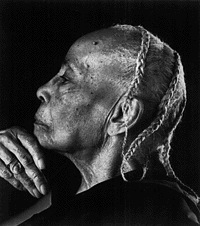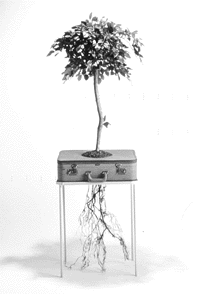https://www.austinchronicle.com/arts/1996-11-29/525678/
Worth a Thousand...
Words Play Off Images in Four New AMOA Exhibitions
By Rebecca S. Cohen, November 29, 1996, Arts
 Septima Poinsette Clark, photographed by Brian Lanker |
AMOA at Laguna Gloria presents drawings by artist Jean-Michel Basquiat accompanied by Kevin Young's poetry, which is presented as art. The 28-year-old Basquiat died in 1988 after a whirlwind career. He ascended from lowly graffiti artist to high art icon, rubbed elbows with the likes of Andy Warhol and Julian Schnabel, and changed art dealers like the rest of us change underwear. His career burned brightly, his life burned itself out. Kevin Young, the poet, was finishing high school in Topeka, Kansas, in 1988. He later graduated from Harvard, got an MFA from Brown, and made a name for himself with his poetry. Young was described in The New Yorker magazine as one of the vanguard African-American poets that could well "turn out to be as important to American letters as the Harlem Renaissance." After seeing Basquiat's work, Young was so moved that he wrote poetry which addresses it. This exhibition allows us to eavesdrop on a conversation between a dead artist and his accomplished admirer, allows us to speculate on their similarities and differences. The two never actually met.
"Fire will attract more attention than any other cry for help." The words belong to Basquiat, not Young. They are scrawled -- all caps -- in oilstick on paper along with the artist's signature crown, a couple of other scribbles, and the following: WHEN THE FOAM BREAKS EVERY SOFA BREAK GLASS TO SOUND SIRENS. A label on the wall reads Untitled (When Foam Breaks), 1981 and "Jean-Michel Basquiat." Is this poetry or art?
On the floor in the upstairs gallery is a huge piece of cardboard, laid out like a bum on the grass, with these words written in oilstick:
The trees told nobody
what, that day, we did --
we died. Laid down
with our cans
of deviled
ham & closed
our eyes -- two
valises full
of Van Camp's
Pork & Beans --
the city an idea
shining far behind --
& we were not afraid...
The poem is called "Brothers Sausage" and in the gallery an exhibition label reads, Brothers Sausage, 1983 and "Kevin Young." Art or poetry?
"Two Cents," the name of the exhibition, which was curated by Amy Cappellazzo, director of the Wolfson Galleries, Miami-Dade Community College, sets up an interesting dialogue, a play on words, a playing with words that muddles the definition of art and poetry. Kevin Young came to the museum during the installation of the show and wrote his poetry on the wall of the front gallery. Other poems are scrawled on paper, on plastic, on the aforementioned cardboard, and one is typed on a translucent yellow paper. It's called "Urgent Telegram to Jean-Michel Basquiat" and begins, "Haven't heard from you in ages stop love your latest show."
Basquiat's drawings on paper -- not to mention his paintings on canvas -- command serious prices when you can find them. The supply of new work has, after all, dried up. However, in some cases, these works represent not much more than words on paper. What is the worth of the poet's words then, cleverly written on a wall, in big capital letters in Basquiat's style?
I am drawn to the words and am sorry to have missed Young's visit to the museum on the day of the opening when he read his poetry and told stories. I am ambivalent about some of Basquiat's drawings -- they look like the unedited scribbles of a disturbed child. Drug dealers, art dealers, and a screwy kind of ambition got in the way of his genius. But when it shines, it shines. Toxic shows off the artist's color sense and complexity, his raw power. A large untitled painting blasts the viewer with energetic red and yellow and gold brush strokes against a black background, haunting faces disappearing into black (or are they pushing outward?). All in all, there's plenty to see at the Laguna Gloria site, lots of words worth the time it takes to read them as poetry or as Jean-Michel Basquiat's visual vocabulary.
"I Dream a World" at AMOA's just-opened 823 Congress location, doesn't just deal with words; it is, in fact, a book. Brian Lanker's photographs of black women were collected into a volume in 1989 and published with a foreword by Maya Angelou. Visual Arts Resources, a nonprofit organization, arranged for the traveling exhibition of the work in that book.
In 1987, award-winning photographer Lanker commenced taking black-and-white photographs of black women "who dreamed of a world not only better for themselves but for generations to come...." They are poets, artists, musicians, social activists, physicians, judges, and educators, many of whom are familiar: Marian Anderson, Shirley Chisholm, Barbara Jordan, Toni Morrison, Rosa Parks, Oprah Winfrey. In addition to taking their pictures, Lanker interviewed these women, speaking with them for an average of three hours at a time. Barbara Summers, the book's editor, was charged with the task of going through these interviews and research materials and distilling one page of first-person explication for each of the 75 women whose portraits appear. The museum text identifies each woman and quotes selectively from the book. Even non-journalists may want to take a pad and pencil and make notes. Better yet, buy the book.
But the photographs are best seen on the wall, exploded in scale, faces so powerful that you don't know where to look first when you walk in the door. In the book's preface, Lanker says, "As a photojournalist, I felt the need to prevent these historical lives from being forgotten." He has certainly accomplished the task. Eleven of his subjects have died since their pictures were taken, but they are very much alive in these photographs, by their words, through their deeds.
Lanker has indeed made an enormous contribution to the history of black women in America, and perhaps to their future as well, but his editor should have directed the book's preface away from his sensitive-American-white-man's confession -- I was unwittingly a racist and sexist, but I'm all better now -- and focused on his interaction with his subjects. I, for one, was less interested in why a white male photojournalist would photograph these 75 stunning women than in what he learned during the two years he traveled throughout the country visiting with them. In any event, the pictures speak louder than the photographer's words and with a fresher and much more compelling voice.
Amongst the photographs in one gallery are a modest collection of small-scale, stylized figures and busts by Selma Burke, selected from national and local collections. The African-American sculptress is best known for her sculpted portrait of President Franklin Roosevelt, which has appeared on the U.S. dime since 1945. The work certainly relates to the photos that surround it, but it is hard to focus on the small sculptures under the gaze of all those strong women! While Burke's bronzes have a sturdy physical presence, the photograph of Priscilla Williams, lauded for "her life of hard work and dedication to the family," is even more tactile. I was certain that if I took my hands out of my pockets, I could reach up and touch her lacy white cap, feel the fur of her coat collar, stroke -- ever so carefully -- her leathery, weathered, sun-kissed cheek.
"De Mujer A Mujer: A Celebration of Latinas by Latina Artists" is the third exhibition showing in the new 823 Congress galleries. It was curated by Amalia Malagamba and organized by AMOA. The first gallery is painted yellow and glows like summer sunlight. Carmen Lomas Garza's black paper cut-outs -- papel picado -- float from the ceiling away from the walls as if by magic. Each depicts Mexico's flora and fauna. They evoke the creation story, Latina-style, with cactus, rattlesnake, eagle, and corn stalks. In the corner of the room, a documentary video produced by the artist about her work plays continuously. This is a mistake. I would have preferred music, I would have preferred the screen available for viewing (at will) in the museum's education room, I would have preferred to listen to the words in my own head as I tried to imagine the process of transforming big black pieces of paper into such ornate and evocative images.
 Transplant, by Irene Perez-Omer |
Kathy Vargas, director of Visual Arts for the Guadalupe Arts Center in San Antonio, presents her signature hand-colored photographs with mixed media. They tell stories with objects that don't quite hold still for the camera and with words. I like the images so much that I've never before followed the loopy script up one side and down the other, but I did at AMOA. In "Miracle Lives, Diana," an artist's husband tells her,"You need to sell this shit or stop making it." The story continues, "Then miracle of miracles, he went away." Another is more predictable -- "Where have all the flowers gone?" for "Desaparecidos #1." The words neither add nor detract.
Austin's Connie Arismendi does not write on her work. She doesn't actually paint, either, or draw (with one exception in this show), or chisel, or carve. Arismendi combines objects, fabrics, colors, and textures into an emotional whole. I don't know how else to describe the psychic weight of her simple assemblages. Using crushed red velvet or red oil in a glass lamp, translucent netting draped over another object or as support for a simple drawing, this artist manages to do a great deal with less. Hers is an eloquent silence.
The same could be said for Irene Pérez-Omer, who presents an installation called Between the Waves, which is dedicated to her grandmother. Rather than a piece of art that might enter our home, the artist has created art that we may enter. We can sit on the pews, handle the prayer books, read the artist's script on the wall, on the gold background of a painting of a strong and beautiful woman wearing an old-fashioned blue dress. Words spiral around candles on a table top and are written all over the back wall. It's like walking into someone's memory box, filled with old letters and photographs, dried flowers, half-burned candles, and a brooch. The artist provides a printed booklet about the installation for those who really like to read. For me, the experience of being there was enough.
"I Dream a World: Portraits of Black Women Who Changed America"; "De Mujer a Mujer: Celebration of Latinas by Latina Artists"; and "Selma Burke Sculpture: Selected Works from National and Local Collections" run through Jan 5 at AMOA Downtown.
"Two Cents: Works on Paper by Jean-Michel Basquiat and Poetry by Kevin Young" runs through Jan 5 at AMOA, Laguna Gloria.
Rebecca S. Cohen is an arts writer and recovering art dealer.
Copyright © 2024 Austin Chronicle Corporation. All rights reserved.
